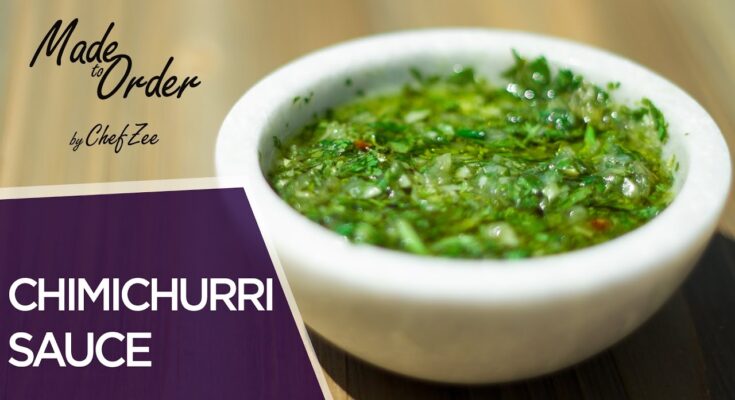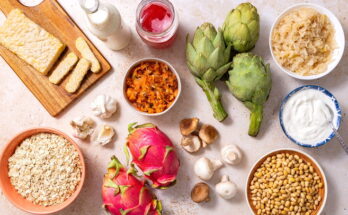Chimichurri Recipe: Chimichurri is a vibrant, flavorful sauce that hails from Argentina and Uruguay, where it is a beloved accompaniment to grilled meats, vegetables, and seafood.
Its bright and tangy taste makes it a favorite worldwide, and once you learn how to make it, you’ll want to use it on just about everything.
In this guide, I’ll walk you through the steps of making authentic chimichurri, with a few variations to suit your taste.
Ingredients for Chimichurri
Before we dive into the step-by-step process, let’s first look at what you’ll need. Chimichurri requires simple, fresh ingredients:
- 1 cup fresh parsley (finely chopped)
- 4-5 cloves garlic (minced)
- 1/2 cup extra virgin olive oil
- 1/4 cup red wine vinegar
- 1 tsp red pepper flakes (adjust to taste)
- Salt and pepper to taste
Optional Ingredients:
- 1/4 cup cilantro (for added freshness)
- Fresh oregano (1-2 tbsp)
- Lemon juice (for extra tang)
The Role of Fresh Herbs in Chimichurri
The key to an exceptional chimichurri is the use of fresh herbs. Traditionally, parsley is the star of the show, but some people like to mix in a bit of cilantro for an additional burst of flavor. While dried herbs may work in a pinch, they simply won’t deliver the same vibrant freshness. Always go for fresh parsley, and if you’re feeling adventurous, toss in some oregano or cilantro.
Parsley vs. Cilantro
Parsley gives chimichurri its grassy, slightly bitter taste, which pairs perfectly with rich meats. Cilantro, on the other hand, offers a citrusy freshness. You can mix the two to customize your flavor.
Choosing the Right Olive Oil
High-quality olive oil is essential in chimichurri because it forms the base of the sauce. Extra virgin olive oil has a fruity, peppery flavor that complements the sharpness of the vinegar and the boldness of the garlic. Avoid cheaper, overly processed oils—they won’t deliver the same depth of flavor.
Vinegar and its Tangy Punch
Red wine vinegar is the traditional choice for chimichurri, providing that signature tangy punch that elevates the sauce. You can experiment with other types of vinegar like white wine or apple cider vinegar, but red wine vinegar gives the most authentic taste. The acidity balances the richness of the olive oil and brings out the vibrancy of the herbs.
The Power of Garlic
Garlic is a crucial component in chimichurri—it adds a punchy, savory flavor that ties the whole sauce together. You’ll want to use fresh garlic, finely minced. The pre-chopped garlic in jars lacks the boldness that fresh cloves provide, so take the extra step to chop it yourself.
Red Pepper Flakes or Fresh Chilies?
Chimichurri traditionally has a bit of heat, which you can adjust to your liking. Red pepper flakes are commonly used, but fresh chilies like red jalapeños or Fresno peppers can also be a great addition if you want more vibrant heat. Add the spice slowly, tasting as you go, so you don’t overwhelm the other flavors.
How to Adjust Salt and Pepper
Salt and pepper are essential to bringing all the flavors together. Salt enhances the taste of the herbs, garlic, and olive oil, while pepper adds a subtle kick. It’s best to add them gradually, adjusting to taste as you mix the sauce.
Step-by-Step Guide to Making Chimichurri
Now, let’s get down to business. Here’s how to make chimichurri in just a few easy steps:
Step 1: Gather all ingredients
Make sure everything is measured and ready to go. Freshness is key here, so wash your herbs and have them ready to chop.
Step 2: Finely chop the herbs
Start by finely chopping the parsley (and cilantro, if using). You want small pieces but avoid turning the herbs into a paste.
Step 3: Mince the garlic
Next, finely mince the garlic. The smaller the pieces, the more evenly the garlic will spread throughout the sauce.
Step 4: Combine herbs, garlic, and spices
In a medium bowl, mix the chopped parsley, garlic, red pepper flakes, and a pinch of salt and pepper.
Step 5: Add olive oil and vinegar
Pour the olive oil and red wine vinegar over the herb mixture. Stir gently to combine, making sure all the herbs are well-coated with the liquid.
Step 6: Mix everything together
Mix everything thoroughly, making sure the ingredients are well-distributed. You want the oil and vinegar to infuse with the herbs and garlic.
Step 7: Let it rest for better flavor
Allow the chimichurri to sit for at least 30 minutes before serving. This resting period lets the flavors meld together for a richer, more complex taste.
How to Customize Chimichurri
Chimichurri is a flexible sauce, and you can adjust it to your taste. Here are some common tweaks:
- For more acidity, add a squeeze of fresh lemon juice.
- To make it spicier, increase the amount of red pepper flakes or add chopped fresh chilies.
- To mellow the flavor, reduce the garlic or use milder herbs.
Chimichurri Serving Suggestions
Chimichurri pairs beautifully with grilled meats like steak, chicken, and lamb. It’s also fantastic drizzled over roasted vegetables, stirred into rice, or used as a marinade for fish or tofu. Try spreading it on sandwiches or using it as a dip for crusty bread.
Chimichurri Variations from Around the World
Though chimichurri originates in Argentina, it has inspired variations across the globe. In some parts of Uruguay, for instance, you’ll find versions with more oregano or spicier profiles. In Brazil, cilantro is often the primary herb, giving it a slightly different flavor.
How to Store Chimichurri
Chimichurri stores well in the fridge for up to a week. Be sure to keep it in an airtight container. If you want to keep it longer, you can freeze it in ice cube trays and thaw as needed. Just note that freezing may slightly change the texture of the fresh herbs.
Health Benefits of Chimichurri
Chimichurri is not only delicious but also packed with health benefits. The fresh herbs provide vitamins A, C, and K, while garlic has immune-boosting properties. Olive oil is a source of healthy fats, which support heart health, and vinegar aids digestion.
FAQs about Chimichurri Recipe
What is chimichurri?
Chimichurri is a vibrant, herb-based sauce originating from Argentina, made with parsley, garlic, vinegar, olive oil, and red pepper flakes. It’s often used as a marinade or a topping for grilled meats, adding a fresh, tangy flavor.
How do I make chimichurri?
To make chimichurri, finely chop fresh parsley, garlic, and red pepper flakes, then mix with vinegar and olive oil. Blend for a smoother texture, or keep it chunky for a rustic feel. You can also experiment with adding cilantro or oregano for variation.
How long does chimichurri last?
When stored in an airtight container in the fridge, chimichurri can last up to one week. Its flavors will develop over time, but it’s best enjoyed fresh within the first few days.
Can I freeze chimichurri?
Yes, chimichurri can be frozen in an airtight container or ice cube trays for up to three months. Thaw in the refrigerator before use and give it a good stir to recombine the ingredients.
What dishes pair well with chimichurri?
Chimichurri is perfect for grilled steak, chicken, and fish. It also works well as a dip for bread, a dressing for salads, or even drizzled over roasted vegetables. The versatility of chimichurri makes it a must-have condiment for various dishes.
Conclusion
Chimichurri is more than just a sauce—it’s a versatile flavor enhancer that can elevate any dish. Its bright, herby, and tangy taste pairs perfectly with grilled meats, vegetables, and even sandwiches. Having chimichurri in your kitchen ensures you always have a quick way to add a burst of freshness to your meals, making it a must-have for home cooks.
Making chimichurri at home is simple and rewarding. Fresh ingredients like parsley, garlic, and olive oil come together to create a sauce that’s infinitely customizable. Whether you like it mild or spicy, homemade chimichurri offers a level of freshness and satisfaction that store-bought versions can’t match. Once you try it, you’ll wonder how you ever lived without it!
References
For further reading and to validate the information provided in this chimichurri recipe, here are some reputable sources:
- AllRecipes – Chimichurri Recipe
- Food Network – How to Make Chimichurri
- Bon Appétit – Authentic Chimichurri Sauce
- BBC Good Food – Classic Chimichurri Sauce
These sources offer detailed steps, variations, and tips to enhance your homemade chimichurri, providing a solid foundation for mastering this flavorful sauce.



